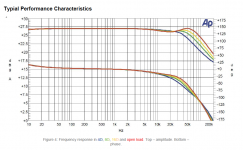Is there a more comprehensive table that includes all the OEM’s products, e.g. Purifi, ICE, Hypex? Price points, distributors for diyer’s, pre-amp needs, gain, etc.
Pnotus comments about the ASX series made me compare those to AS series. I found some things that might be interesting so I will put out there for knowledgeable members to help me understand the relevance to sound.
View attachment 877256
Looking into the AS series, and knowing the ICEedge chip makes a difference, I noticed "Output referenced idle noise" drops significantly for the 1200AS vs the others. Checking the ASX I was surprised to find similar levels (even lower) for the 50ASX2, especially the BTL at 20uV. Also the 50ASX2BTL has 125 dB dynamic range, the closest to 129dB displayed by the 1200AS.
Next I looked into THD+N at 1W and 1 kHz also into the graphs to get THD+N at 10W and 6.67kHz. Interestingly, ASX modules seem to perform better at 1KHz, which the AS, and in particular 1200AS, do better at 6.7kHz.
How important are these parameters when selecting an amp for a midrange channel?
Is there a more comprehensive table that includes all the OEM’s products, e.g. Purifi, ICE, Hypex? Price points, distributors for diyer’s, pre-amp needs, gain, etc.
Sorry, I wasn't attempting it to be a comprehensive table. I was comparing Icepower AS vs ASX lines.
The thread is about state of the art in class D and I didn't mean to derail it. Excellent info provided in the thread. It took me a couple of re-reads to grasp some aspects. For example, Kurt's post #3 already says the ICEedge chip was only implemented in the 1200AS...it didn't sink in the first time I saw it.
Here's a comparison of 1200AS2 and 50ASX2 THD+N into 8ohm from their datasheets, that portraits better than the table I posted.
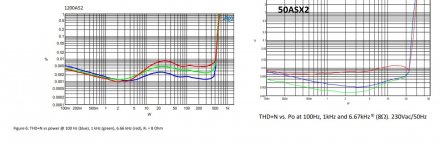
While 1200W is waaay too much for midrange with a 97dB sensitivity/8ohm driver, in reality 1200W is into 2 ohm. THD stays low until about 400W into 8ohm - still more than plenty.
The 50ASX2 stays composed until 20W into 8ohm, which should be fine for me.
But looking at the blue line (1kHz):
The 50ASX2_ goes from about 0.003% at 1W to 0.005% at 20W, while
the 1200AS2 goes from about 0.0015% at 1W to 0.0025% at 20W.
So half the THD+N within 1 to 20W, with the additional upside of plenty of power if I ever needed (for another application).
Seems the 1200AS2 is the way to go. Am I missing something important?
I´ve already mentioned earlier that we were building a class D amp ourselves.
Here you can see pics of the design.
It is intended for use with an external psu, which can be both a smps or a linear one. We´ve dicided to design an additional board with rectification, extra capacity and regulators needed for low voltage supply for linear supplies.
Then only transformers are needed alongside with the boards.
See picture below (the linear supply board has not yet been tested IRL)
Anyways when somebody is crazy enough, to go along with this kind of projects, one cannot do only 5 amps or so, as the costs for higher numbers are just the same.
Therefore we have some to spare for the moment.
Later on we might do a complete datasheet on it, until then a preliminary datasheet is available.
Corona did have an impact on our time schedule afterall.
Best regards
Søren
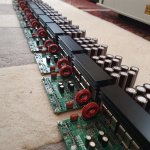
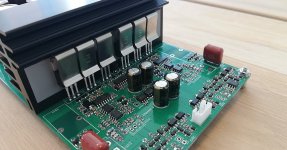
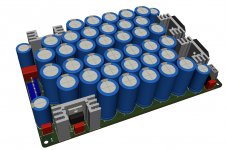
View attachment Datasheet - eLABS Tomahawk Class-D amplifier - Rev 0,1-1.pdf
Here you can see pics of the design.
It is intended for use with an external psu, which can be both a smps or a linear one. We´ve dicided to design an additional board with rectification, extra capacity and regulators needed for low voltage supply for linear supplies.
Then only transformers are needed alongside with the boards.
See picture below (the linear supply board has not yet been tested IRL)
Anyways when somebody is crazy enough, to go along with this kind of projects, one cannot do only 5 amps or so, as the costs for higher numbers are just the same.
Therefore we have some to spare for the moment.
Later on we might do a complete datasheet on it, until then a preliminary datasheet is available.
Corona did have an impact on our time schedule afterall.
Best regards
Søren



View attachment Datasheet - eLABS Tomahawk Class-D amplifier - Rev 0,1-1.pdf
Member
Joined 2018
Is this IcePower Characteristics?
A few week ago, I had a chance to hear the IcePower 250A amplifier. It sounds massive bass Low-end, but remarkable loosing Hi-frequency range details and responses. I felt the output tone is not constant. After that, now I understand to see the Typical Performance Characteristic chart. Frequency response is depends on output levels. Attached graph is 500A Typical Performance Characteristic, another series also has same characteristics. If you choose too much Hi-Power IcePower Unit, you will be hear the lower graph performance sounds....
Seems the 1200AS2 is the way to go. Am I missing something important?
A few week ago, I had a chance to hear the IcePower 250A amplifier. It sounds massive bass Low-end, but remarkable loosing Hi-frequency range details and responses. I felt the output tone is not constant. After that, now I understand to see the Typical Performance Characteristic chart. Frequency response is depends on output levels. Attached graph is 500A Typical Performance Characteristic, another series also has same characteristics. If you choose too much Hi-Power IcePower Unit, you will be hear the lower graph performance sounds....

Attachments
That graph can't explain what you heard. The only significant difference in response is above 20KHz. Which (a) are frequencies not present in 99% of recorded music, and (b) you can't hear anyway.
I'm not sure what you mean? We se different frequency at different loads. It's common knowledge to change output coils to fit the impedance load of the loudspeaker.
A few week ago, I had a chance to hear the IcePower 250A amplifier. It sounds massive bass Low-end, but remarkable loosing Hi-frequency range details and responses. I felt the output tone is not constant. After that, now I understand to see the Typical Performance Characteristic chart. Frequency response is depends on output levels. Attached graph is 500A Typical Performance Characteristic, another series also has same characteristics. If you choose too much Hi-Power IcePower Unit, you will be hear the lower graph performance sounds....
That´s not the way I know the old A modules.
First of all the A modules are more than twenty years old.
Next of all I don´t remember them as you say.
They are not really done as ultimate fidelity amplifiers, i.e. they have electrolytics directly in the signal path, to protect against DC input.
But given that, I think they had a decent sound quality, without blowing the roof away.
I'm not sure what you mean? We se different frequency at different loads. It's common knowledge to change output coils to fit the impedance load of the loudspeaker.
Is it really common knowledge to change output coils to fit load impedance?
This i don´t think is correct.
That might be true to amplifiers where the filter is placed outside the loop(s).
For amps with the filter included in the loop(s), this is definately not true at all.
Best regards
Søren
Yes, but the only significant difference is at frequencies that will not be present in the musical signal you are amplifying.
After that, now I understand to see the Typical Performance Characteristic chart... snip
No, you dont.
//
To me the graph shows very good performance. Over the band of frequencies that will be in the music signal (up to 20KHz) the response is the same for different load impedances. This is good as speaker impedance varies with frequency. An "8 ohm" speaker might easily vary between 4 ohms to 30 ohms at different frequencies.
That the response varies a bit above 20KHz really is not significant, the music signal you are amplifying should not have any signal at those frequencies.
That the response varies a bit above 20KHz really is not significant, the music signal you are amplifying should not have any signal at those frequencies.
Kubik, any measurements on the amp? Homepage for product?
//
We did a lot of measurements on the amp.
The results are to find in the preliminary datasheet.
Power, and THD as a function of power will be documented later on, because we do not yet have our own SMPS or lineary supply ready.
But THD is competitively low I can assure.
OK. But I didn't see any graphs (output impedance, distorsion vs freq).
IMD / Multitone?
What does it look like above 20k?
//
IMD / Multitone?
What does it look like above 20k?
//
Is it really common knowledge to change output coils to fit load impedance?
This i don´t think is correct.
That might be true to amplifiers where the filter is placed outside the loop(s).
For amps with the filter included in the loop(s), this is definately not true at all.
Best regards
Søren
OK I'm no expert I just thought there was a optimum filter for a specific load.
https://www.eetimes.com/understanding-output-filters-for-class-d-amplifiers/
This is not to prove I'm right, just to show from where I have my knowledge. But Im no engineer som might interpret wrongly. I also see many discussions about the best value for different loads in the tpa 32x threads
Last edited:
If the filter is in the FBL, the output will follow the input - right?
Many class D amps don't.
//
Many class D amps don't.
//
OK I'm no expert I just thought there was a optimum filter for a specific load.
https://www.eetimes.com/understanding-output-filters-for-class-d-amplifiers/
This is not to prove I'm right, just to show from where I have my knowledge. But Im no engineer som might interpret wrongly. I also see many discussions about the best value for different loads in the tpa 32x threads
The articel linked to, is about output filters in class D amplifiers alone. That means outside any loops.
Including the filter inside the loop will change the game significantly.
Member
Joined 2018
Hi Kurt von Kubik -San, and all responded members.
According to the datasheet, 20kHz response appx. -4dB down relative to the 40Hz (Lower level graph trace shows). The sound I heard was also the same as something as like that.
It' was easy to hear the difference from the other conventional amplifiers.
We can see the some datasheets at parts-express page.
[500A]
https://www.parts-express.com/pedoc...500a-class-d-amp-module-1x500w-data-sheet.pdf
[500ASP]
https://www.parts-express.com/pedoc...0asp-class-d-amp-module-1x500w-data-sheet.pdf
[1000A]
https://www.parts-express.com/pedoc...00a-class-d-amp-module-1x1000w-data-sheet.pdf
[1000ASP]
https://www.parts-express.com/pedoc...asp-class-d-amp-module-1x1000w-data-sheet.pdf
[50ASX2SE]
https://www.parts-express.com/pedocs/manuals/326-112--icepower-50asx2se-class-d-amp-datasheet.pdf
Maybe we can say, The IcePower A-series is not a state of the art design. A design which have feedback loop after the re-construction filter will be more stable responses even if the load impedance changed.
Actually, It is very difficult to implement that into the stable circuit design...
According to the datasheet, 20kHz response appx. -4dB down relative to the 40Hz (Lower level graph trace shows). The sound I heard was also the same as something as like that.
It' was easy to hear the difference from the other conventional amplifiers.
We can see the some datasheets at parts-express page.
[500A]
https://www.parts-express.com/pedoc...500a-class-d-amp-module-1x500w-data-sheet.pdf
[500ASP]
https://www.parts-express.com/pedoc...0asp-class-d-amp-module-1x500w-data-sheet.pdf
[1000A]
https://www.parts-express.com/pedoc...00a-class-d-amp-module-1x1000w-data-sheet.pdf
[1000ASP]
https://www.parts-express.com/pedoc...asp-class-d-amp-module-1x1000w-data-sheet.pdf
[50ASX2SE]
https://www.parts-express.com/pedocs/manuals/326-112--icepower-50asx2se-class-d-amp-datasheet.pdf
Maybe we can say, The IcePower A-series is not a state of the art design. A design which have feedback loop after the re-construction filter will be more stable responses even if the load impedance changed.
Actually, It is very difficult to implement that into the stable circuit design...
- Home
- Amplifiers
- Class D
- Current state of the art Class D?
